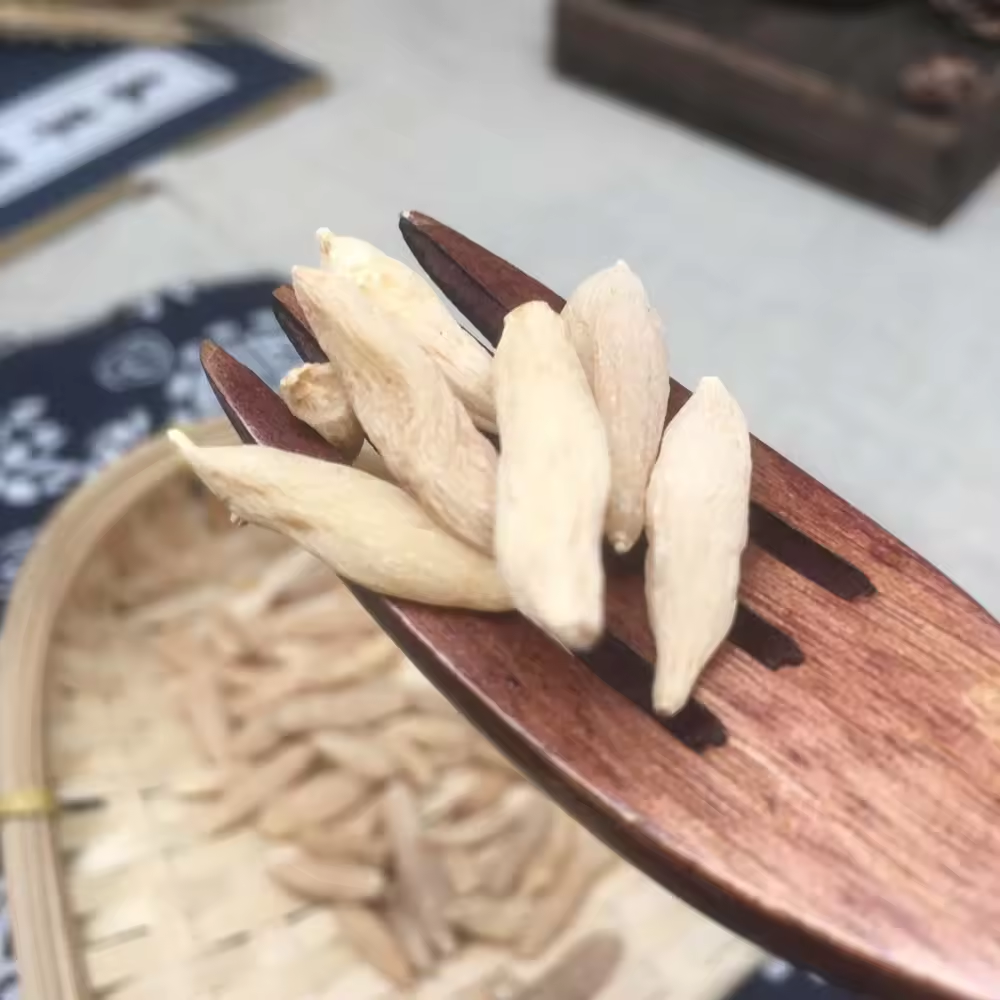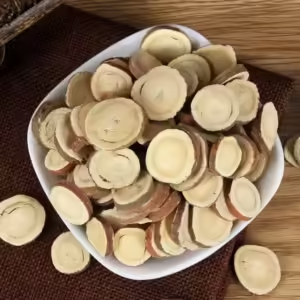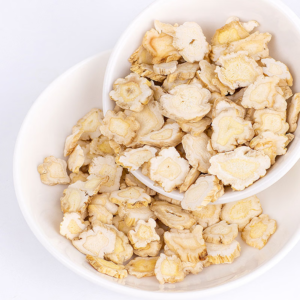Ophiopogon japonicus
[Family and medicinal part] This product is the tuberous root of the plant Ophiopogon japonicus of the Liliaceae family.
[Nature and flavor and meridians] Sweet, slightly bitter, slightly cold. Enters the heart, lung, and stomach meridians.
[Effects] Clears the heart and moistens the lungs, nourishes the stomach and produces fluid.
[Clinical application] 1. Used for lung yin injury, dry cough, hemoptysis, and restlessness.
Ophiopogon japonicus is a refreshing product that can not only moisten the lungs and relieve cough, but also clear the heart and reduce fire. It can be used to treat lung deficiency and heat cough, hemoptysis, etc., and can be used with Adenophora scabra, Asparagus cochinchinensis, Rehmannia glutinosa, etc.; it can be used to clear the heart and relieve restlessness, and can be used with Bamboo Leaf Roll Heart, Lotus Seed Heart, etc.
2. Used for symptoms such as lack of fluid and thirst.
Ophiopogon japonicus can nourish stomach yin and produce fluid, so it can be used for symptoms such as yin deficiency and internal heat, stomach yin loss, lack of fluid and thirst, and is often used in combination with Dendrobium officinale, Adenophora scabra, Asparagus cochinchinensis, Rehmannia glutinosa, Polygonatum odoratum, etc.
[Prescription name] Ophiopogon japonicus, Ophiopogon japonicus, Ophiopogon japonicus (referring to those produced in Jiangqiao, Zhejiang), Cun Ophiopogon japonicus (referring to those that are thick and full of inches) (wash and dry for use).
[General dosage and usage] One to three coins, decocted and taken.
[Comments] 1. Ophiopogon japonicus tastes sweet and cool, is soft and juicy, is good at nourishing dryness and moistening dryness, nourishing yin and producing fluid, is good at treating lung and stomach deficiency heat, and can clear the heart and relieve troubles.
2. This product also has the function of clearing heat, moistening dryness and lubricating intestines, similar to Scrophularia ningpoensis. The two medicines are often used together for heat disease damage to body fluid, dry intestines and constipation. If it is spleen and stomach deficiency and cold, loose stools or dampness, it is not suitable for use.
3. Ophiopogon japonicus and Asparagus cochinchinensis are both sweet, cold and moist medicines. The effects of nourishing yin and moistening dryness are similar, so they are often used together for symptoms such as lung yin injury, dry cough and less sputum. However, Ophiopogon japonicus moisturizes the lungs and nourishes the stomach and clears the heart; Asparagus cochinchinensis moisturizes the lungs and nourishes the kidneys, and its nature is relatively cold. For symptoms such as insufficient stomach yin, irritability, thirst, etc., use Ophiopogon japonicus more often; for symptoms such as kidney yin deficiency, hot flashes and spermatorrhea, use Asparagus cochinchinensis more often.
[Example of prescription] Yiwei Decoction “Treatise on Warm Diseases”: Ophiopogon japonicus, Adenophora Root, Radix Rehmanniae, Polygonatum odoratum, crystal sugar. Treats stomach heat and fluid depletion.
【Literature Excerpt】《本经》: “It is used to treat qi stagnation in the heart and abdomen, injury to the middle and fullness, stagnation of stomach collaterals, emaciation and shortness of breath.”
《别录》: “It treats consumptive heat, dry mouth and thirst… It calms the lung qi and soothes the five internal organs.”
《本草蒙泉》: “Asparagus and Radix Ophiopogonis… can relieve restlessness and thirst, relieve cough and eliminate phlegm. They have similar functions, but they are actually superior. Radix Ophiopogonis… often clears the heart and reduces fire, so that the lungs are not affected by evil, so it can stop coughing immediately; Radix Ophiopogonis… often nourishes the kidney and helps the essence… so it has a special effect in eliminating phlegm.”
Where is the main medicinal part of Radix Ophiopogonis?
Medicinal part of Radix Ophiopogonis:
This product is the dried root of Ophiopogon japonicus (L.f) Ker-Gaw., a plant of the Liliaceae family. It is dug in summer, washed, and repeatedly exposed to the sun.
Pile until it is 70% to 80% dry, remove the fibrous roots, and dry.
Characteristics of the medicinal part of Ophiopogon japonicus:
This product is spindle-shaped, with slightly pointed ends, 1.5~3cm long and 0.3~0.6cm in diameter. The surface is light yellow or grayish yellow with fine vertical lines. It is soft and tough, straight yellow-white when broken, translucent, and the middle column is small. It has a slight fragrance and tastes sweet and slightly bitter.
How are Ophiopogon japonicus recorded in ancient books?
“Ben Jing”: “It is used to treat qi stagnation in the heart and abdomen, injury to the middle and fullness, severance of the stomach and collaterals, emaciation and shortness of breath. Long-term use will make the body light and not old or hungry.
“Famous Doctors’ Records”: “It can treat heaviness of the body and yellow eyes, fullness under the heart, asthenia and guest heat, dry mouth and thirst, stop vomiting, cure paralysis, strengthen yin and benefit essence, digest food and regulate the middle, protect the spirit, stabilize the lung qi, calm the five internal organs, and make people fat and healthy.
“Materia Medica”: “It can treat heat toxins, stop thirst, and treat swelling of the face and limbs due to water retention. It can treat pulmonary tuberculosis and pus vomiting, and it can treat spermatorrhea.
“Rihuazi Materia Medica”: “It can treat five kinds of labor and seven kinds of injuries, calm the soul and spirit, treat seasonal fever, headache, and stop cough.
“Compendium of Materia Medica”: “It can treat deficiency heat in the heart and lungs.
“Compendium of Materia Medica”: “Ophiopogon japonicus is a medicine for clearing the heart and moistening the lungs.
“Compendium of Materia Medica”: “Ophiopogon japonicus has a sweet taste and rich cream, so it is specially used to nourish stomach yin and body fluid.
Effects
Ophiopogon japonicus has the effects of moistening the lungs and nourishing yin, benefiting the stomach and producing body fluid, clearing the heart and removing troubles.
What are the main effects and clinical applications of Ophiopogon japonicus?
Ophiopogon japonicus is used for dry cough due to lung dryness, tuberculosis due to yin deficiency, sore throat and pharyngitis, thirst due to body fluid injury, internal heat and thirst, restlessness and insomnia, and dry intestines and constipation.
Treatment of lung yin deficiency
·Insufficient lung yin, dry cough It is often used together with Asparagus cochinchinensis for treating less sputum, blood in sputum, dry nose and sore throat; it is often used together with Rehmannia glutinosa, Scrophularia ningpoensis, Fritillaria cirrhosa, etc. for treating Yin deficiency and dry lung, dry throat and sore throat, dry cough with less sputum or blood in sputum. Treatment of stomach Yin deficiency
·Heat damages stomach Yin, dry mouth and tongue, often used together with Rehmannia glutinosa, Polygonatum odoratum, Adenophora scabra, etc.;
Treat thirst due to fluid damage, or internal heat and thirst, often used together with Radix Trichosanthis, Radix Pseudostellariae, Prunus mume, etc.;.
·Treat heat damage to fluid, dry intestines Constipation, often used with raw rehmannia and Scrophularia.
Restlessness
· Treat yin deficiency and internal heat, palpitations and insomnia, often used with raw rehmannia, spinach seeds, cypress seeds, etc. · Treat heat damage to the heart, restlessness and insomnia, often used with coptis, raw rehmannia, Scrophularia, etc.
What other effects does Ophiopogon have?
The commonly used medicinal diet recipes of Ophiopogon are as follows:
Dry throat, difficulty swallowing, nausea and vomiting
Ophiopogon 10g, raw rehmannia 15g, lotus root 20g 0g, appropriate amount of rock sugar.
Take Ophiopogon japonicus, Rehmannia glutinosa, and lotus root, wash and chop them separately, put them into a pot, add appropriate amount of water and boil, add rock sugar, and cook for another 40 minutes, remove the residue and take the juice, let it cool and take it in portions.
Nausea and vomiting during pregnancy
50g each of fresh Ophiopogon japonicus juice and fresh Rehmannia glutinosa juice, 10g ginger, 15g coix seed, and 50~100g polished rice.
First cook the coix seed, polished rice and ginger. Then add Ophiopogon japonicus Mix the juice of Ophiopogon japonicus and Radix Rehmanniae, cook into porridge. Eat in several times.
Cough, dry lips and tongue
5g of almonds, 10g of Radix Ophiopogonis.
Crush the almonds, chop the Radix Ophiopogonis, add appropriate amount of water to the above two flavors, boil for 20 minutes, remove the residue and take the juice, add honey, and let it cool. Take it in several times.
What are the compound preparations containing Ophiopogonis japonicus?
· Maiwei Dihuang Pills: nourish the kidneys and lungs. Used for lung and kidney yin deficiency, hot flashes, sweating, dry cough and blood, Dizziness, tinnitus, sore waist and knees, thirst.
·Xuanmai Ganju Lozenges: Clears heat and nourishes yin, removes phlegm and relieves sore throat. Used for yin deficiency and excessive fire, floating virtual fire, dry mouth and nose, sore throat.
·Qinghuo Zhimai Pills: Clears heat and detoxifies, cools blood and reduces swelling. Used for sore throat, fever, toothache, and red eyes caused by excessive heat in the lungs and stomach.
·Shengmai Drink: Replenishes qi and restores pulse, nourishes yin and produces body fluid. Used for deficiency of both qi and yin, shortness of heart qi, weak pulse and spontaneous sweating.
·Yin nourishment Qingfei Paste: nourishes yin and moistens dryness, clears the lungs and relieves sore throat. Used for yin deficiency and dry lungs, dry throat, dry cough with little sputum or blood in sputum.
· Erdong Paste: nourishes yin and moistens the lungs. Used for dry cough with little sputum, blood in sputum, dry nose and sore throat caused by insufficient lung yin.
· Yiwei Decoction: nourishes yin and benefits the stomach. Indications: stomach yin damage syndrome. Burning pain in the stomach, loss of appetite, dry mouth, dry stool, or retching and hiccups.
· Zengye Decoction: increase fluid and moisten dryness. Yangming Febrile disease, constipation due to deficiency of body fluid. Constipation, mouth.
Qingying Decoction: Clears the body fluid and detoxifies, penetrates heat and nourishes yin. Indications: Heat enters the body fluid. Body heat is severe at night, restlessness and insomnia, delirium from time to time, eyes often open or close, mouth.
Thirst or not thirsty, macules are faint.
Modern research progress on Ophiopogon japonicus
This product has multiple pharmacological effects such as lowering blood sugar, sedation and hypnosis, relieving asthma, enhancing immunity, delaying aging, protecting the myocardium, and reducing blood viscosity.
Usage
Ophiopogon japonicus has the effects of moistening the lungs and nourishing yin, benefiting the stomach and producing body fluid, clearing the heart and removing troubles. It can be taken with more decoction, or soaked in water, cooked porridge or soup. But no matter which method is used, it needs to be taken according to the doctor’s instructions.
How to use Ophiopogon japonicus correctly?
· When Ophiopogon japonicus decoction is taken orally, the common dose is 6~129.
· When Ophiopogon japonicus is used externally, it can be ground into powder for application; decoction for application; or fresh product can be mashed into juice for application.
·For nourishing the lungs and stomach, removing the heart is more important, while nourishing the yin and clearing the heart is more important.
Ophiopogon japonicus is generally used in decoctions, decocted for consumption, or made into powder or pills for consumption. However, the use of Chinese medicinal materials must be based on syndrome differentiation and treatment, and should be used under the guidance of professional Chinese medicine practitioners. It should not be used at will, and should not be used at will, let alone listen to Chinese medicine prescriptions and advertisements.
In addition, Ophiopogon japonicus can also be used for daily health care, and the common methods of consumption are as follows:
· Make tea: Boil water with Ophiopogon japonicus to nourish yin and moisten the lungs.
· Ointment (Erdong ointment): Asparagus cochinchinensis and Ophiopogon japonicus are equal. Add water to decoct the concentrated juice, add about the same amount of refined honey to boil together, and eat 1 spoon each time. It is used for cough due to yin deficiency and lung heat or tuberculosis, dry throat and thirst, fever or hot flashes,
Cook porridge (Ophiopogon japonicus and corn porridge): 15g Ophiopogon japonicus, 10g fresh bamboo leaves, and 100g corn. Ophiopogon japonicus and bamboo leaves are boiled in water to obtain the medicinal juice, and the corn is boiled with water until half cooked, and then the medicinal juice is added, and then the porridge is cooked. Ophiopogon nourishes yin and clears the heart, bamboo leaves clear the heart and eliminate irritability, and millet nourishes the stomach and eliminates irritability and heat. It is used for heart heat and irritability, thirst, and red tongue with little fluid.
Note: Do not take it if you have a cold or cough with phlegm, or if you have loose stools due to spleen deficiency. In addition, people with spleen and stomach deficiency, weak constitution, and prone to diarrhea should use Ophiopogon with caution
How to prepare Ophiopogon?
Ophiopogon: Take the original medicinal material, remove impurities, wash, moisten, flatten, and dry.
Red Ophiopogon: Take clean Ophiopogon, spray a little water and mix well, moisten slightly, add fine cinnabar powder, shake up and down and mix well, take out, and dry. For every 100kg of Ophiopogon, use 2kg of cinnabar powder.
What drugs should be used with Ophiopogon with special attention?
The combined use of Chinese medicine and the combined use of Chinese and Western medicine requires syndrome differentiation and treatment, and clinical individualized treatment.
If you are using other drugs, please consult a doctor before taking the medicine, and inform the doctor of all your diagnosed diseases and treatment plans you are receiving.
Instructions for use
Ophiopogon japonicus is slightly cold and moisturizing, so it is not suitable for people with wind-cold or phlegm cough, spleen deficiency and loose stool.
What are the precautions when using Ophiopogon japonicus?
People with spleen and stomach deficiency, poor appetite and loose stool, as well as those with wind-cold and phlegm cough should not take it.
·Clinically, when using Ophiopogon japonicus as a tonic to replenish deficiency, attention should be paid to syndrome differentiation. Improper use will cause dampness and phlegm, and adverse reactions such as excessive phlegm, bland mouth, and poor appetite will occur. Pregnant and lactating women: If you are pregnant, planning to become pregnant, or are lactating, please inform your doctor in time and consult whether Chinese medicine can be used for treatment.
·Children: Children’s medication must be carried out under the guidance of a doctor and adult supervision.
·Please properly store the medicinal materials and do not give the medicinal materials you use to others.
How to identify and use Ophiopogon japonicus?
Asparagus cochinchinensis and Ophiopogon japonicus
Asparagus cochinchinensis and Ophiopogon japonicus can nourish yin and clear lung heat, moisten dryness and produce body fluid, and can treat lung heat and dry cough, yin deficiency and cough with blood, internal heat and thirst, and dry intestinal constipation. However, Asparagus cochinchinensis is stronger than Ophiopogon japonicus in clearing lung heat and nourishing lung yin; in addition, Asparagus cochinchinensis can also nourish kidney yin, and is good at treating bone steaming, hot flashes, night sweats, and spermatorrhea caused by kidney yin deficiency.
Ophiopogon japonicus can also nourish the stomach and produce fluid, clear the heart and relieve restlessness, and is good at treating dry mouth and tongue caused by febrile diseases or long-term illness and fluid damage, and restlessness and insomnia caused by yin deficiency and heat or febrile diseases and heat entering the heart and camp
Medication tips
The most frequently asked questions by patients
How to make autumn pear paste
[Preparation and usage] Chop the pears, squeeze the juice, add water to the pear residue and boil it again, filter the juice, and combine the two juices for later use; add 10 times the amount of water to Ophiopogon japonicus, winter flower, lily, and Fritillaria, boil for 1 hour, filter out the medicinal liquid, add 6 times the amount of water and boil for 30 minutes, filter out the medicinal juice, mix the two liquids, and add pear juice. When it is concentrated to a thin paste over low heat, add crushed rock sugar powder, stir to dissolve, and cook for a while. Take it twice a day with warm water. 【Efficacy and Application】Nourishes yin and produces fluid, moistens the lungs and relieves cough. It is suitable for yin deficiency and lung heat, cough without sputum, or less and thick sputum, even chest tightness and shortness of breath, dry mouth and throat, irritability and hoarseness, etc.
What are the effects and functions of Maimendong Decoction?
Maimendong Decoction comes from “Golden Chamber Synopsis” and is a dryness treatment agent. It has the effects of clearing and nourishing the lungs and stomach, and lowering the adverse qi. It is mainly used to treat deficiency-heat lung atrophy syndrome, with symptoms of cough and asthma, throat discomfort, uncomfortable sputum, or coughing with saliva, dry mouth and throat, hot hands and feet, red tongue with little coating, and weak pulse; insufficient stomach yin syndrome, with symptoms of vomiting, poor appetite, hiccups, thirst and dry throat, red tongue with little coating, and weak pulse. It is clinically used to treat chronic bronchitis, bronchiectasis, chronic pharyngitis, silicosis, pulmonary tuberculosis, etc., which are caused by lung and stomach yin deficiency and qi and fire upward. It also treats gastric and duodenal ulcers, chronic atrophic gastritis, and vomiting during pregnancy, which are caused by insufficient stomach yin and qi reverse vomiting.
Who is Shengmai Yin suitable for?
Shengmai Yin is suitable for people with Qi and Yin deficiency, with symptoms such as palpitations, shortness of breath, dizziness, fatigue, insomnia, dry mouth, involuntary sweating or sweating profusely after a little exercise.
If the patient has the above symptoms, he can consider taking Shengmai Yin under the guidance of a doctor. Usually, the symptoms will be significantly improved after taking this product for 4 weeks.





















Reviews
There are no reviews yet.